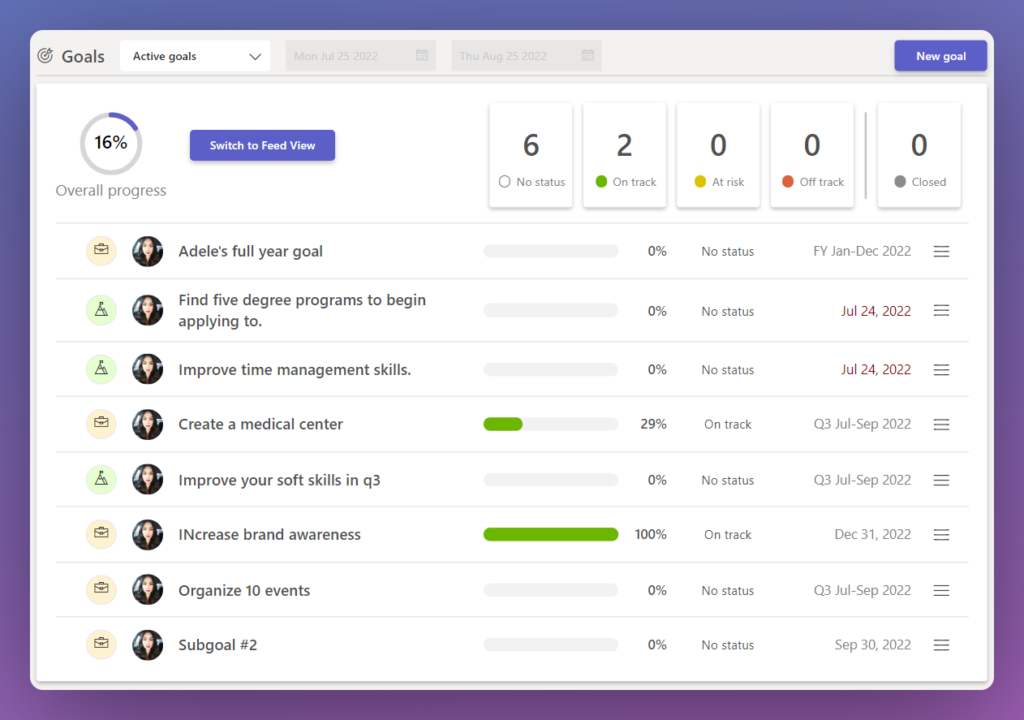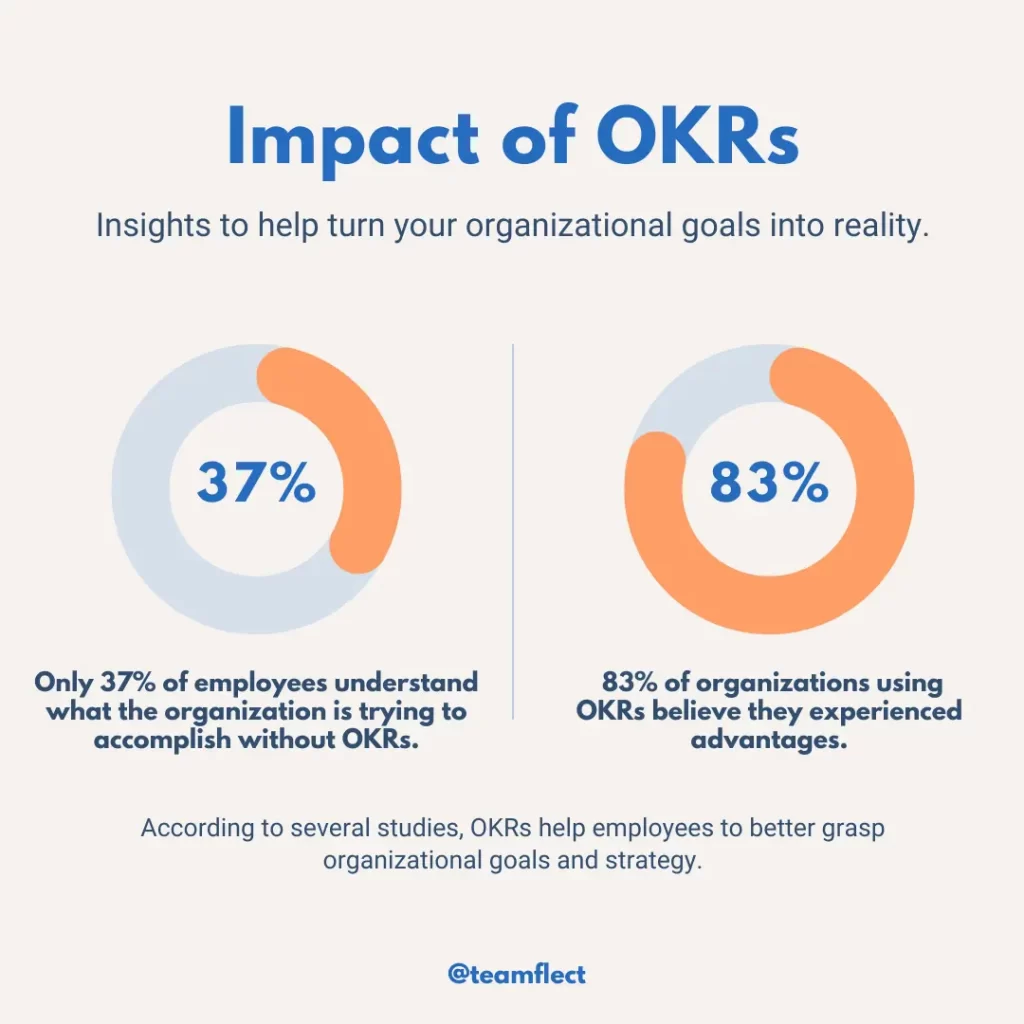Objective and Key Results (OKRs) is a leading performance management methodology that has been adopted by many successful companies around the world.
But how can it be implemented on a personal level for the professional while at the same time aligning with company-wide objectives?
Is there any conflict between this new expectation and other goals already in place?
What would be the best way to formulate personal OKRs?
There are several ways you could answer these questions, and we will explore some of them with this article!
Table of Contents
OKR and Performance Management: How do they work together?
What is Performance Management?
In one of our former posts, we defined performance management as the ongoing communication process between a supervisor and an employee that is present throughout the year’s cycle that supports accomplishing the organization’s strategized objectives.
The process involves clarifying expectations, setting objectives, identifying goals, providing feedback, and reviewing results. Employee engagement is a set of processes and systems that aim at developing employees, so they achieve the best results from their job.
This approach doesn’t aim to improve all skills—it focuses on enhancing the skills relevant to an employee’s particular role. This helps them become their best self in those areas; therefore, this is about aligning one’s work output with the goals of the group and organization.
While having a closer look at this definition, Objective and Key Results comes in as a tool of performance management that covers and aids this process on numerous levels.

What are OKRs?
OKRs can be used to set, communicate, and monitor goals within an organization so that all employees work together toward a common goal. OKR is the unifying tool that addresses every aspect of figuring out the best way to work with others and gives this movement a clear sense of direction.
The system’s elegance lies in its ability to efficiently provide a simple practice framework for defining, tracking, and measuring goals, both as something to aspire to and something that can be measured. The purpose of OKRs is to restructure alignment and give people a sense of purpose by facilitating engagement and focus.
OKRs stimulate performance by holding the moment for autonomous motion within the confines of organizational structure.
In the fast-paced environment of today’s working world, OKR software is a handy performance management tool that can help cut down on time consumption. The result is a wide variety of OKR software available for different organizations, depending on what their needs are.
Additionally, having the right OKR software can smooth out engagement processes and make implementation easier to track and monitor. If you would like to learn more about user-friendly Goal and OKR tracking software, check out our Goals & OKRs page!

Team OKRs
OKRs on a team-level are a widely used goal-setting framework that helps teams focus on achieving specific objectives.
What are objectives, you might ask. Objectives are qualitative, inspirational goals that define what the team aims to accomplish. Objectives provide a clear direction and purpose for the team’s efforts and helps everyone understand the ultimate goal they are working towards.
Key results, on the other hand, are specific and measurable outcomes that indicate the team’s progress towards achieving the defined objectives. Key results should be quantifiable and time-bound in order to provide a concrete way to evaluate success. Think about key results as checkpoints which will allow your team to track their performance and understand whether they are on the right path.
The process of setting Team OKRs involves collaboration and engagement among team members. It’s crucial to involve everyone in the goal-setting process, as this encourages a sense of ownership and commitment to the objectives. When team members have a say in defining the OKRs, they become more motivated and accountable to achieve them.
An important study done by Haufe shows that among employees who use OKRs, about 60% possess a clear grasp of their company’s strategy. In contrast, in companies that do not use OKRs, this understanding is only observed in approximately 37% of employees.

Another study done by Mooncamp for their OKR Impact Report suggests that 83% of organizations that implemented OKRs believe they have experienced advantages from using this goal-setting framework. That’s why we encourage you to use OKRs for your goals!
Sample Team OKRs
If you’re looking for some sample team OKRs, check out our department-wise OKR suggestions:
- Sales Team:
Objective: Increase revenue generation and market share- Key Result 1: Achieve 20% increase in monthly sales revenue.
- Key Result 2: Expand market share by 15% in target regions.
- Key Result 3: Onboard and train 3 new sales representatives to strengthen the team.
- Marketing Team:
Objective: Improve brand awareness and engagement- Key Result 1: Increase website traffic by 30% through organic channels.
- Key Result 2: Grow social media followers by 20% with engaging content.
- Key Result 3: Launch successful influencer marketing campaign, generating 10% more leads.

- Product Development Team:
Objective: Enhance product usability and user satisfaction- Key Result 1: Achieve a product usability score of 85% based on user feedback.
- Key Result 2: Reduce customer support tickets by 25% through product improvements.
- Key Result 3: Launch three new product features based on customer needs and preferences.
- Customer Support Team:
Objective: Provide Exceptional Customer Service- Key Result 1: Achieve a customer satisfaction rating of 95% or higher in post-interaction surveys.
- Key Result 2: Reduce average response time to customer inquiries by 20%.
- Key Result 3: Conduct customer service training sessions to enhance team skills.
- Human Resources Team:
Objective: Enhance employee engagement and retention- Key Result 1: Conduct employee satisfaction survey with a participation rate of 90%.
- Key Result 2: Implement three new employee engagement initiatives based on survey feedback.
- Key Result 3: Reduce employee turnover rate by 15% through targeted retention strategies.
Personal OKRs
Personal OKRs are just like team OKRs, just applied at an individual level. OKRs can be used as a powerful tool for personal development, self-improvement, and achieving personal goals. Personal OKRs follow the same structure as team or organizational OKRs but are focused on an individual’s aspirations, growth, and accomplishments.
Objectives for personal OKRs are the overarching goals that individuals aim to achieve. They represent the desired outcomes and provide direction for personal development.
Key results are specific and measurable outcomes that indicate progress toward achieving the objectives. They serve as milestones and help individuals track their performance and success.
Setting Personal OKRs should follow determining the things that matter most to the individual and creating a plan to work towards achieving them. Personal OKRs can cover various aspects of life, including career growth, health and fitness, personal relationships, learning new skills, and more.

Sample Personal OKRs
If you’re interested in setting personal OKRs for your professional and daily life, here are some personal OKR examples you can implement:
Professional Personal OKRs
- Objective: Expand professional network and connections
- Key Result 1: Attend at least two industry conferences or networking events to make new connections.
- Key Result 2: Connect with at least five industry professionals on LinkedIn every month.
- Key Result 3: Actively participate in online professional forums or groups, engaging in meaningful discussions at least once a week.
- Objective: Develop presentation and public speaking skills
- Key Result 1: Participate in a public speaking workshop to develop presentation and speaking techniques.
- Key Result 2: Deliver at least three successful presentations to clients or colleagues within the next six months.
- Key Result 3: Seek feedback from peers and supervisors after each presentation to identify areas for improvement.
- Objective: Improve time management and productivity
- Key Result 1: Reduce time spent on non-essential tasks by 20% through better prioritization.
- Key Result 2: Complete all tasks from the to-do list by the end of each workday for a week.
- Key Result 3: Increase focus during work hours by implementing the Pomodoro Technique for two hours daily.
Daily Life Personal OKRs
- Objective: Increase physical well-being
- Key Result 1: Exercise for at least 30 minutes every day for five days a week.
- Key Result 2: Maintain a balanced diet with at least five servings of fruits and vegetables each day.
- Key Result 3: Achieve a minimum of 7 hours of quality sleep on average per night.
- Objective: Cultivate mindfulness and reduce stress
- Key Result 1: Practice mindfulness meditation for 10 minutes daily, aiming for five days a week.
- Key Result 2: Take a 15-minute break every afternoon to relax and recharge away from work.
- Key Result 3: Engage in a calming hobby, such as reading or painting, for at least two evenings per week.

Team vs. Personal OKRs
With OKR adoption, each company must decide on the levels at which OKRs will be set and how far down they should go—should OKRs apply to individuals or just teams?
The goal is to make sure that every employee has his or her own set of goals. This model seems simple, but it has been used for decades by large organizations—including big tech companies, but when it comes to implementation, some problems may occur.
OKR is a framework where the right objectives, key results, and metrics are set up early on to track progress across all departments of an organization. When personal OKRs are overemphasized, they become a list of things to do rather than the framework for meaningful work.
Here’s an example of team OKRs for the marketing team:
Objective: Get 15K monthly users to our website for Q4 of 2022.
Key Result: Post at least 2 blog posts every week.
Key Result: Expand the distribution method of the blog using Google Ads.
Key Result: Implement call-to-action (CTA) on the main page for new visitors.
If a person is solely and entirely responsible for delivering on an assigned metric—for example, if they own that metric as part of their team’s set goals —then this will ensure the successful use of OKRs: the focus in such situations would be 100% aligned with what was needed to succeed. A successful executive producing customers at the level of retention and upselling, and a sales manager responsible for profit and margin would be examples of the earlier scenario.
When we zoom out and look at the larger picture, however, we see several distinct methods by which teams form or disband to reach shared goals that nullify personal OKRs. How much of the success of an IT team working on a project would contribute to the overall success of the marketing team or vice versa? This could be difficult to measure and create conflict within teams.
Let’s take a look at this example of personal OKRs for a member of the marketing team:
Objective: Create more creative marketing campaigns for Q4 of 2022.
Key Result: Launch 20% more campaigns.
Key Result: Read books about marketing techniques.
Key Result: Take design classes.
As you can see, although these OKRs are beneficial to the employee and the overall success of the marketing team, they do not necessarily align with the OKRs of the company.
Personal OKRs increase complexity since you will have to make different OKRs for each member instead of creating collective OKRs for the whole team. This could increase complexity by 3 times to 10 times depending on the team size!
That is why several companies have abandoned individual OKRs for most roles. For example, Spotify found that extending the OKR process to the individual level became superfluous —it slowed them down without adding value.
The Pros and Cons of Personal OKRs
As an effective way of connecting strategies with execution on a company and team level, some companies also adopt personal OKRs to add an extra level below their team OKRs. However, before implementing personal OKRs throughout the company, you must weigh all the advantages and disadvantages of doing so.
There are several pros of personal OKR implementation, such as it enables performance management on an individual level, employees’ performance becomes more trackable by the Human Resources management if it falls in the same line as team OKRs, and it brings actual benefit to all parties involved if the OKR framework is sustained harmoniously.
OKR is not about individual performance evaluation. It focuses on employees, teams, andwork output of the entire organization that delivers the most significant business impact.
Personal OKRs involve each employee, which obviously will be beneficial for making every employee a part of the OKR setting process. Many companies keep OKRs on a company and team level, but they let all employees set “initiatives”, which are things you do to achieve an OKR.
Using personal OKRs in addition to company and team OKRs might be a hassle since employees could see them as a business chore rather than a choice, resulting in failure to achieve OKRs. Therefore, this complexity could be considered a con of adding personal OKRs to the OKR adoption and implementation processes.
Another downside of setting personal OKRs is that they might move your set goals away from the original aim of the framework. Your employees might miss the main goals of your company while focusing on the personal OKRs they were given.
Lastly, such practice might restrain the employee, rubbing them off the opportunity to bring growth onto the table and execute with their expertise and purposes.

Who Should Be The Owner of OKRs?
The answer to whom to assign OKRs is “it depends”.
There are, however, certain factors on which the decision depends:
- The way a company is structured
- The way a company chooses to set OKRs
- The decision-making autonomy of a given employee
- The type of OKR
- The stage at which the company is, regarding the implementation of the OKR process
Fundamentally in setting OKRs, there would be three ways in which they can be organized:
- Top-down
- Bottom-up
- Negotiation
In a few words, a few basic rules can apply:
- Employees without decision-making authority should not own company aligned OKRs
- The exception is individual, non-aligned OKRs.
- Employees with full decision-making authority should always own OKRs.
- Objectives are usually vague.
- The manager usually comes up only with a goal; employees with OKRs.
- Employees with some decision-making authority should always own OKRs
- Objectives are usually specific.
- The manager has input on OKRs.
Frequently Asked Questions
How to set personal OKRs?
Setting personal OKRs can be broken down into 5 essential steps:
- Define your objectives: Detect your most inspiring and challenging goals.
- Create measurable key results: Set specific and measurable outcomes for your goals.
- Keep it few: Limit key results to 2-5 per objective.
- Stay consistent: Set Key results directly relate to objectives.
- Review and adjust: Regularly assess your progress and make adjustments as you need.
How to set team OKRs?
Setting team OKRs is a little bit more complicated than setting personal OKRs, but you can follow these 9 steps:
- Understand organizational objectives: Start by grasping your organization’s top-level goals.
- Identify team goals and objectives: Define specific, time-bound team objectives aligned with the company’s mission.
- Define measurable key results: Determine quantifiable outcomes that indicate progress.
- Ensure alignment and balance: Keep team OKRs aligned with the company’s objectives and balanced in ambition.
- Involve the team: Encourage active participation from all team members.
- Regularly review progress: Hold check-ins to track performance and make adjustments.
- Provide support and resources: Ensure the team has the necessary tools and support.
- Celebrate achievements: Acknowledge and celebrate successes along the way.
- Iterate and improve: Conduct retrospectives to improve the process for the next cycle.




